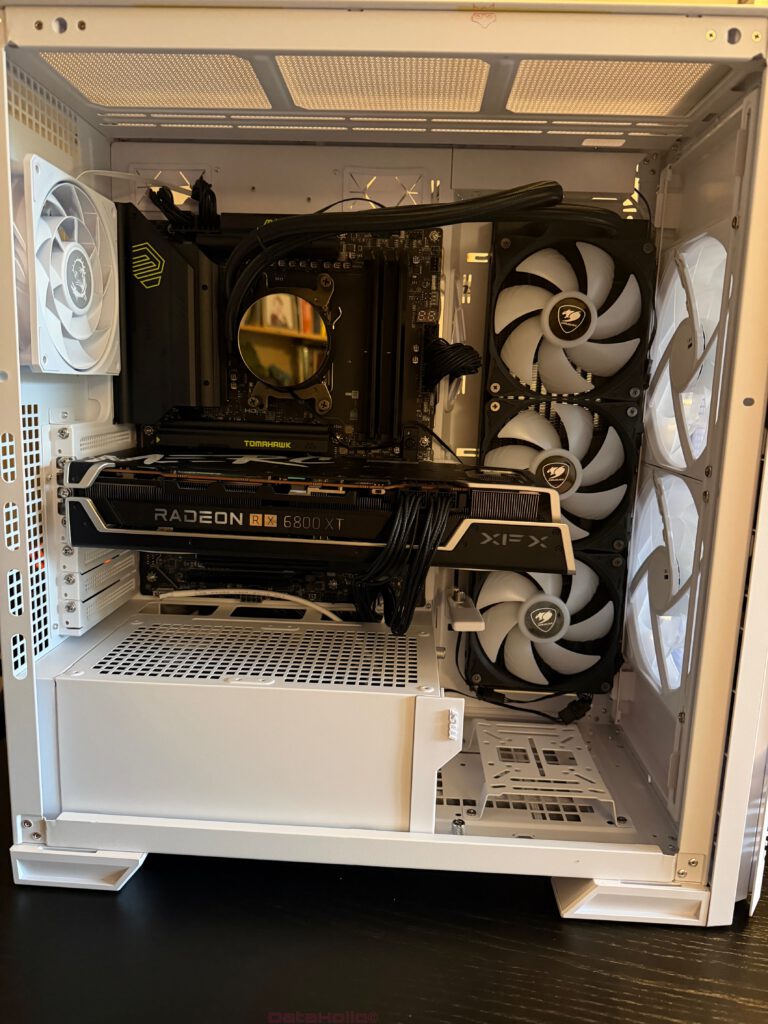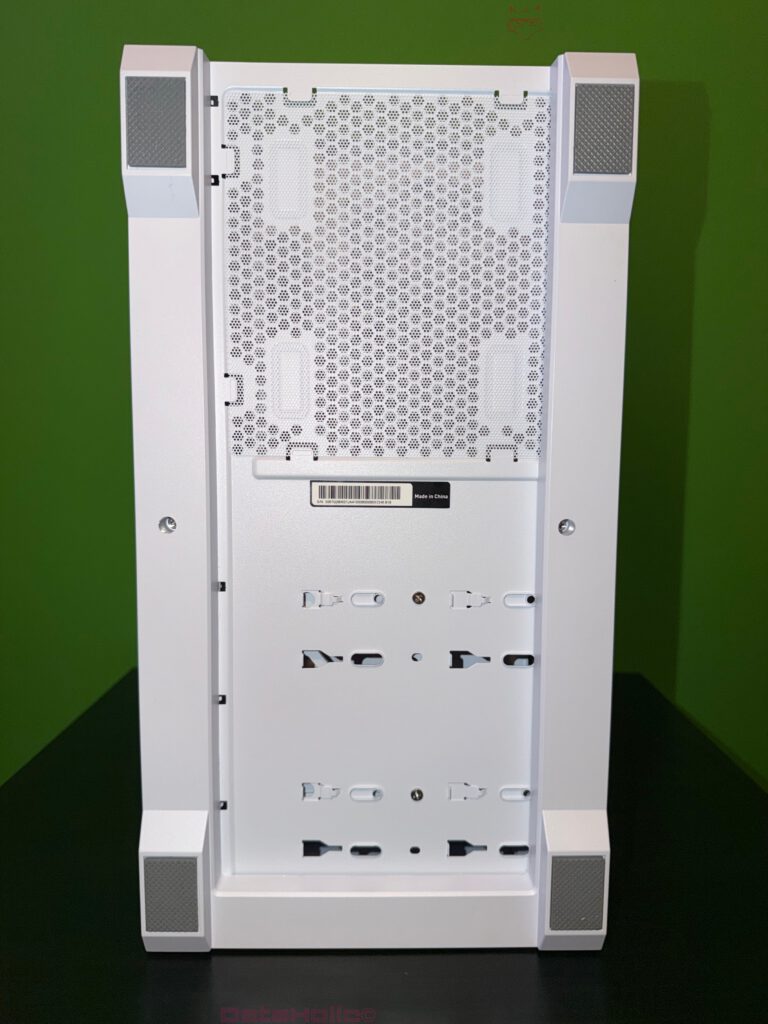Conclusion: MSI MPG Velox 300R Airflow (Project Zero)
There are cases that push themselves into the spotlight and shout “Look at me!”. And then there are those that simply do their job, stay out of your way, and let your hardware shine. The MSI MPG Velox 300R Airflow (Project Zero) definitely belongs to the second category — in the best possible way.
After assembling our test system – Ryzen 9, RX 6800 XT, a beefy air cooler, and plenty of cables – one thought kept coming up: “So this is how relaxed a PC build can be in 2025?”
Build Quality & Stability: Project Zero Without Flex or Fuss
The Velox 300R Airflow PZ looks like a classic mid-tower, but the chassis clearly targets the new back-connect / Project Zero generation. The frame is sturdy, the side panels slide cleanly into their rails, nothing rattles — even when the fully built system is moved around.
With the PZ concept, stability is crucial because PZ motherboards rely on additional cutouts and routing channels to hide cables behind the tray. This case handles that without any drama:
- The motherboard tray is stiff and doesn’t bend under load.
- All cable openings are properly deburred — nothing digs into your cables or fingers.
- Even a fully populated E-ATX board (up to 305×278 mm) sits securely, without the wobble you often find in cheaper mid-towers.
A small anecdote from the build: While installing the heavy RX 6800 XT, the case slid a bit on the desk — but the rubber feet held, and the side panel didn’t budge. That’s exactly the moment where you notice the line between “acceptable” and “solid”.

PZ & Non-PZ Support: Freedom Instead of Forced Compatibility
A huge advantage: Both Project Zero / back-connect boards and traditional front-connect boards fit perfectly into the Velox 300R Airflow. So buying this case doesn’t lock you into a single ecosystem.
- Mini-ITX, mATX, ATX, and E-ATX all fit comfortably.
- The back-connect cutouts are already in place, with generous cable routing on the backside.
- Traditional boards with front connectors fit just as well — the cable openings are exactly where you need them.
In practice, this means: you can start with a “normal” motherboard today and switch to a Project Zero board later without replacing the case. In short: you buy the Velox 300R once — not for just one platform generation.
Interior Space: Generous Without Wasting Air
A quick look inside reveals what MSI prioritized: space and airflow. Our test system proves the point nicely:
| Hardware | Manufacturer |
|---|---|
| Mainboard | MSI MPG B870E Tomahawk WIFI |
| CPU | AMD Ryzen 9 9900X |
| RAM | Crucial Pro DDR5 64 GB (4×16) |
| SSD | Kingston 2TB PCIe 4.0 NVMe M.2 |
| CPU Cooler | AMD Wraith Cooler |
| Graphics Card | AMD Radeon RX 6800 XT |
| Power Supply | MSI MPG A1000GS PCIe 5 |
| Tower | MSI MPG Velox 300R Airflow |
| Monitor | LC-M27UFD |
| Keyboard | Dygma Defy |
| Mouse | Logitech MX Vertical |
| Mousepad | MSI True Gaming |
Even with powerful components, thick cable bundles, and multiple fans, the interior remains tidy:
- Long graphics cards up to roughly 400 mm are no problem.
- Tall CPU coolers fit easily without colliding with RAM or the side panel.
- The full-length PSU shroud hides cables effectively and features a quick-release mechanism that makes upgrades painless.
Anyone who has ever cursed at a rigid PSU cover knows how much this improves the overall experience: fewer scratched knuckles, fewer contortionist tricks, and less frustration.
Cable Management: The Hidden Highlight
You often only realize a case is well engineered once you start routing cables. Here, the Velox 300R Airflow shines: there’s enough room for every cable — especially for PZ builds.
- The back side offers plenty of depth, plus several Velcro straps and routing loops to keep cables tight and organized.
- The cutouts are placed exactly where you need them — especially near the motherboard 24-pin and GPU connectors.
- A built-in fan/RGB hub reduces header clutter and supports complex builds without needing five splitter cables.
The end result: almost all cables disappear entirely. From the front, the interior looks clean and almost clinical — especially with the white colorway in our setup.
There’s a fitting quote: “Perfection is achieved not when there is nothing more to add, but when there is nothing left to remove.”
The Velox 300R embodies that nicely. You see only what matters — everything else hides exactly where it belongs.

Fan Mounting & Cooling Options: Airflow in Name and Reality
The name says it all: Airflow. The case is built for ventilation from front to back — and third-party measurements confirm that it competes extremely well with dedicated airflow champions.
Pre-installed fans include:
- 2× 160 mm ARGB fans at the front
- 1× 120 mm fan at the rear
These use a dual-layer blade design to maximize air pressure and minimize vibration. MSI claims measurable CPU/GPU temperature improvements — and independent tests back that up, albeit with higher noise at maximum RPM.
Expansion options are equally generous:
- Front: up to 3×120 mm, 3×140 mm, or 2×160 mm
- Top: up to 3×120 mm or 3×140 mm
- Multiple locations for pump mounts, bottom fans, or accessories
- Supports up to three 360 mm radiators simultaneously
In our configuration (RX 6800 XT, Ryzen 9, stock fans), temperatures stayed impressively low, even under long gaming or rendering loads. In summer heat, when your room feels more like a studio than a basement, the case still doesn’t become the bottleneck.

Airflow in Practice: Real-World Behavior
Of course, exact values depend on the components and curve tuning, but the trend is consistent:
- Under heavy load, CPUs and GPUs often remain between 60–70°C, sometimes lower with optimized curves.
- The mesh front, top, and side sections feed cool air straight to the hotspots.
- A slight positive pressure helps keep dust out of the interior.
The compromise: those huge 160-mm fans are audible at full speed. Not harsh, not whiny — just present. A good fan curve fixes this easily, and in daily use, the system stays pleasantly quiet; under full load, it becomes “audible but totally acceptable.”
Dust Protection & Maintenance: Built for Real-World Use
Dust protection is something many cases fail at — but not this one. MSI included sensible, daily-usable solutions:
- Magnetic top and front filters that can be removed in seconds.
- A full-length bottom dust filter, removable from the rear — not perfect, but functional.
Give the filters a quick clean every few weeks and the system stays tidy without buildup.

Design: Understated with Subtle Gaming DNA
Visually, the Velox 300R Airflow PZ neither blends in completely nor tries too hard. MSI avoided the “spaceship gamer aesthetic” and instead went for modern, clean lines:
- A large mesh front with angled sides adds character without overdoing it.
- The tempered-glass panel shows your hardware unobstructed.
- MSI and MPG branding remain subtle and tasteful.
Especially in white, the case looks cohesive and premium — without mismatching tones or cheap-looking paint, an issue in many budget white cases.
Life With Project Zero: A Clear View, No Cable Clutter
The biggest benefit becomes obvious when using a back-connect motherboard:
- Power, data, and front-panel cables disappear entirely behind the tray.
- From the front, you see only the hardware: GPU, cooler, RAM, fans — nothing else.
Whether you care about aesthetics or just want fewer cables in the way when upgrading parts, Project Zero inside this case is a real upgrade in day-to-day usability.
A friend in the hardware community likes to say:
“A good case is one where you don’t need band-aids after the build.”
This case fits that nicely.
Small Downsides: No Case Is Perfect
A few things you should know:
- Noise at maximum RPM The large front fans move a lot of air but become noticeable at high speed. Not unbearable, just not silent.
- Bottom filter accessibility The bottom filter slides out backwards. Not a dealbreaker, but a side/front pull tab would have been more convenient.
- Design subjectivity Some users consider the case “a bit generic.” Depending on your taste, that might be a drawback — or a strength, because the design ages well and avoids gimmicks.
None of these are serious flaws, but they help frame expectations.

Price-to-Performance & Who This Case Is For
Priced comfortably in the upper mid-range, the Velox 300R Airflow faces strong competition — yet stands out because it offers:
- Full PZ and non-PZ compatibility
- Excellent airflow
- Thoughtful cable management
- Strong build quality
- Practical comfort features
- Great radiator/fan support
The ideal users are:
- PC enthusiasts building powerful systems
- RGB and showcase PC fans
- Upgraders planning future PZ transitions
- Airflow-focused users who prioritize performance
If you want an ultra-silent or compact case, this isn’t the perfect match. But if you want a reliable, performance-driven, highly flexible mid-tower — this is a strong contender.
Final Thoughts: A Case You’ll Recommend to Others
After hours of building, adjusting cables, and hunting down dropped screws, the overall impression is clear:
The MSI MPG Velox 300R Airflow (Project Zero) isn’t a case that begs for attention. It’s more like a good studio technician — in the background, reliable, unflashy, and essential for everything to run smoothly.
- Plenty of room for tall coolers, long GPUs, and powerful PSUs
- Accepts both PZ and traditional boards
- Comes with strong stock fans and extensive cooling support
- Exceptional cable management
- Solid construction with user-friendly features
It may not be the absolute quietest or the most aggressively styled case, but the overall balance of performance, flexibility, and build quality makes it a great foundation for both current and next-gen PC builds — especially if you want to explore the advantages of Project Zero.
In short: If you’re looking for a sturdy, future-proof airflow case for high-end or upper-midrange hardware, the MSI MPG Velox 300R Airflow is an excellent choice.
Transparency Notice (as required by EU regulations):
The MSI MPG Velox 300R Airflow featured in this review was provided to us by MSI as a non-binding loan for testing purposes. This is not paid advertising.
MSI had no influence on the content, rating, or editorial independence of this article. All opinions expressed are based solely on our own hands-on experience.
We sincerely thank MSI for providing the case and for their trust in dataholic.de.
